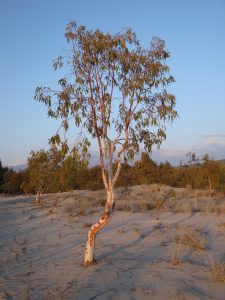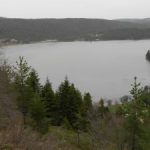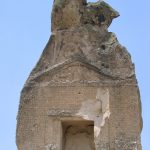Turkey’s finest beach Population: 850
Favourite son: St Nicholas
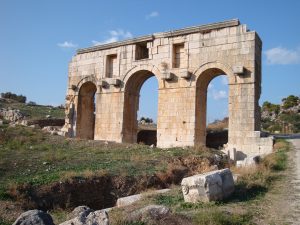 Patara is well known for having one of the best beaches in Turkey, 20km of soft white sand that stretches out 1.5km south of the village of Gelemiş with not an ugly high-rise hotel to spoil the vista. What is less well known is that some of the beach is still truly wild, a place where you can come and find yourself with only the waves for company, a place where you can walk for hours and rarely encounter another soul. To find that more isolated part of the beach you have to divert away from the road that links the village of Gelemiş to the main stretch of sand. Do that and you will find yourself lost amid some of Turkey’s finest ancient ruins as well.
Patara is well known for having one of the best beaches in Turkey, 20km of soft white sand that stretches out 1.5km south of the village of Gelemiş with not an ugly high-rise hotel to spoil the vista. What is less well known is that some of the beach is still truly wild, a place where you can come and find yourself with only the waves for company, a place where you can walk for hours and rarely encounter another soul. To find that more isolated part of the beach you have to divert away from the road that links the village of Gelemiş to the main stretch of sand. Do that and you will find yourself lost amid some of Turkey’s finest ancient ruins as well.
As for Gelemiş, it’s not somewhere to get too excited about, consisting of a ramshackle collection of pensions and restaurants with the odd slightly larger hotel looking as if it’s strayed from nearby Kalkan.
Backstory
Patara started life as a Lycian settlement and there is plenty of evidence of Lycian presence here in the form of the massive sarcophagi scattered around the fields, each of them with a gaping hole where treasure-hunters have forced their way inside in search of gold.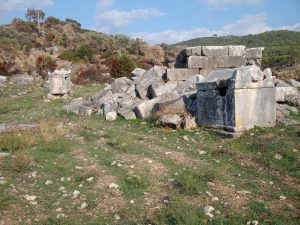
Later the town became famous for an oracle that was sacred to Apollo. However, archaeologists have not so far found any trace of it.
The town had the usual convoluted history up until 42 BC when the Roman senator Brutus heard rumour of its wealth and forced the locals to surrender to Rome. Regardless, it seems to have remained an important place where Sts Paul and Luke changed ship on their way from Miletus to Jerusalem.
It was around 300 that St Nicholas, Patara’s most famous son, was born. Over the centuries he was slowly transformed from a mere provincial bishop into Santa Claus AKA Father Christmas. He’s buried in Demre/Kale a little further east along the coast.
But as at Ephesus (Efes) so at Patara. Slowly the harbour that had been the source of its wealth silted up until eventually ships could no longer use it. After that the town fell into decline until by the early 19th century British explorers could report that there was no one living there any more.
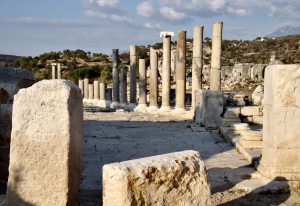 Ancient Patara
Ancient Patara
As you walk down to the beach you will quickly arrive at the remains of a triumphal arch that was erected in 100 AD for the local governor, Mettius Modestus. Then a little to the south you pass the remains of a large bathhouse and then of a basilica where it is perhaps a little too fanciful to imagine St Nicholas having preached.
From here you can either head on south to the sand, or cut inland towards the remains of a stretch of wall. Near here, archaeologists have uncovered a long stretch of marble pavement lined with shops with a colonnade running along each side of it, the İstiklal Caddesi, perhaps, of its day. It’s a short walk north from here to explore what is left of a temple to Apollo which seems to have folded in on itself, its huge entrance cracked at the top and trees growing inside what must once have been the sanctuary of the god. An oracle is supposed to have issued forecasts to worshippers throughout the winter months.
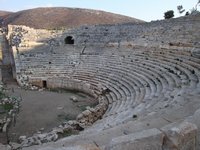 However amazing all this is, it’s mere window-dressing compared with the real gem of Patara, which is a wonderful and virtually undamaged theatre dating back to the first century. This owes its fantastic state of preservation to the sand, which, over the centuries, flowed across its thirty rows of marble seats, thus protecting them. The sand has since been cleared away, leaving behind an incredibly evocative place to sit and ponder the fall of empires.
However amazing all this is, it’s mere window-dressing compared with the real gem of Patara, which is a wonderful and virtually undamaged theatre dating back to the first century. This owes its fantastic state of preservation to the sand, which, over the centuries, flowed across its thirty rows of marble seats, thus protecting them. The sand has since been cleared away, leaving behind an incredibly evocative place to sit and ponder the fall of empires.
Near the theatre a bouleterion (council chamber) with seating for 400 councillors has been completely restored. It is believed that the Lycian League used to hold meetings of what might have been the world’s first parliament in a building dating back to the 1st century AD here. Later it was used for concerts and theatrical entertainments before being incorporated into the city wall as a bastion.
Scramble up the hill behind the theatre to find what seems to have been the city’s acropolis and where there is still an impressive cistern. From here a path winds round a stagnant stretch of water, all that remains of the once vital harbour. On its far shore stand the remains of a huge granary paid for by the Emperor Hadrian in the second century and looking as if it must have been built from the same blueprint used for the one at Andriake, near Demre/Kale.
An ancient stone lighthouse at the site was restored in the 2020s.
From the path to the granary head west across the sand dunes to reach the more isolated part of the beach. As at İztuzu Beach, near Dalyan, these sands are popular with Caretta caretta (loggerhead) turtles who come up onto the sand to lay their eggs from May to October. It is at least in part due to the efforts of turtle fans that development at the beach has been prevented so please stick to the rules drawn up to protect the eggs and the baby turtles.
Sleeping
Flower Pension. Tel: 0242-843 5164
Golden Pension. Tel: 0242-843 5162
Patara View Point Hotel. Tel: 0242-843 5184
Transport info
Regular buses ply the coast road from Antalya to Fethiye, passing the turn-off for Patara.
In summer, there’s the odd minibus straight to Gelemis. Out of season, however, you may have to walk the last 3.5km of the journey down to the village and may need your pension owner’s help to get back up to the main road.
Day trip destinations
